Access is a great tool by Microsoft that allows users to organize and manage large amounts of data in the form of forms, queries, tables, and reports. In this post, we will look at various ways to fix Microsoft Access Runtime Errors 2501, 424, 13, 6, 3052, 3146, 3027, 2471, 3343, 3027, etc. and what triggers them. These errors occur when a user tries to launch Access or when the app is running. Sometimes, a runtime error goes away after restarting MS Access, and if not, there are straightforward ways to resolve the issue.
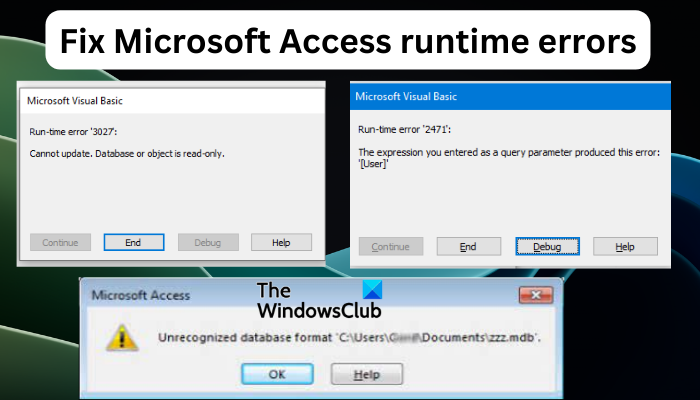
Microsoft Access runtime errors usually pop up in a small window in the middle of the screen. The error shows that a runtime error has occurred and issues an error code. It also advises a user to contact the support team for further assistance. The most noticeable symptom of this error is the program crashes when you click OK on the error pop-up.
Why do I get Microsoft Access Runtime Errors?
Runtime Errors are caused by almost similar general triggers, but this is not always the case. For instance, some Access code errors are caused by incompatible programs running in the background, virus or malware attacks, or graphic driver issues. It can also be caused by an unstable internet connection or an outdated Microsoft Office. If you are running too many programs at the same time, you might the Access runtime code errors. This is because there is insufficient memory to run Access which makes it fail or crash unexpectedly. We will look at each error with its specific causes and solution later.
Fix Microsoft Access Runtime Errors
Runtime errors are not fatal to your apps but are a nuisance especially if you depend on the MS Office for business or personal tasks. To fix Microsoft Access runtime errors, we need to look at what triggers them and then troubleshoot the problem. In this section, we will look at how to fix various Access runtime errors. Use the following solutions:
- Perform preliminary steps
- Try error-specific steps
- Close incompatible background programs
- Update MS Office
- Scan system files
- Run the Disk Cleanup tool
- Update your graphics driver
Let us now go deeper into each solution in detail.
1] Perform preliminary steps
 The Microsoft Access runtime error is not a huge problem and can be fixed by running a few simple preliminary steps. Try to fix the issue by doing the following;
The Microsoft Access runtime error is not a huge problem and can be fixed by running a few simple preliminary steps. Try to fix the issue by doing the following;
- Restart your App or your PC. This will work if the error is caused by temporary bugs and glitches. The system will fix them automatically when you restart the app or the program.
- Check your internet connection. Test your internet and see if the speeds are good and that it’s stable. If not, try to reconnect to Wi-Fi or Ethernet cables. If nothing works here, reach out to your ISP for further assistance.
If no preliminary resolves the error, try the methods below.
2 Try error-specific steps
Microsoft Access runtime error 2501: This error occurs without a warning and can reoccur severally if not resolved. The popup message is ‘Error 2501: Microsoft Access has encountered a problem and needs to close. We are sorry for the inconvenience’. To fix this error reinstall Microsoft Visual C++ Redistributable Package.
Microsoft Access runtime error 424 object required: This error shows the message ‘Object required’. The issue occurs when the Visual Basic Editor doesn’t recognize the form you are working on. To fix this, you need to invoke the Code Builder for the form or any object in the form; one time is enough per object.
Microsoft Access runtime error 3044: The cause of this error is a mismatch when a user enters an invalid file with an invalid path specification on MS Access. To fix this error, download and install Access Data Engine Redistributable here. Here is the error message: ‘Error: 3044 ‘(Path)’ Isn’t a Valid Path. Make Sure that the Path Name is Spelled Correctly and that you are connected to the Server on which the File Resides’.
Microsoft Access runtime error 3343: This error indicates that there is an unrecognized database format. It occurs when launching the Queue Monitor. The main cause is a corrupted frxque32.mdb file in the FRx Queue directory or SysData folder. To fix this, rename this file to something like frxque32.mdb.old. Locate the frxque32.tp file in the C drive and rename it to frxque32.mdb.Finally, restart the app.
Microsoft Access runtime error 3052: This error occurs when there many transactions in the process when editing PGDB. If the number of locks required to process a transaction is beyond the maximum number of locks per file, error code 3052 will appear. You will have to edit the Registry if you see File sharing lock count exceeded error 3052.
Microsoft Access runtime error 2471: This is a Microsoft Visual Basic error that shows the message ‘The expression you entered as a query parameter produced this error’. To fix this error put apostrophes or single quotes around the matching currency. For example, dblFXRate = DLookup(“[FXRate1]”, “qry_GetFxCurr”, “[FuncCurrency] = ‘” & Me.cboCurrency & “‘”)
Microsoft Access runtime error 13 type mismatch: Users get this error in the process of setting up FW company as the default. It is caused by the availability of many FRx versions on a server or workstation. The .dll file might be in conflict or not registered correctly. To fix this error, go to the FRx directory and run the FRxReg.exe file.
Microsoft Access runtime error 3027 cannot update: This error shows the message ‘Run-time error 3027 Cannot update. Database or object is read-only’, and can be fixed by removing the VBA code from the file
Microsoft Access runtime error 3146 ODBC call failed. This error happens when the network connection is faulty. It is caused by corrupted Windows system files. To fix ODBC error code 3146, you need to replace ODBC 1.x Driver Manager (Odbc.dll) with ODBC 2.x Driver Manager in the primary path.
If these solutions don’t work you may try the following methods to resolve Microsoft Access runtime errors.
3] Close incompatible background programs
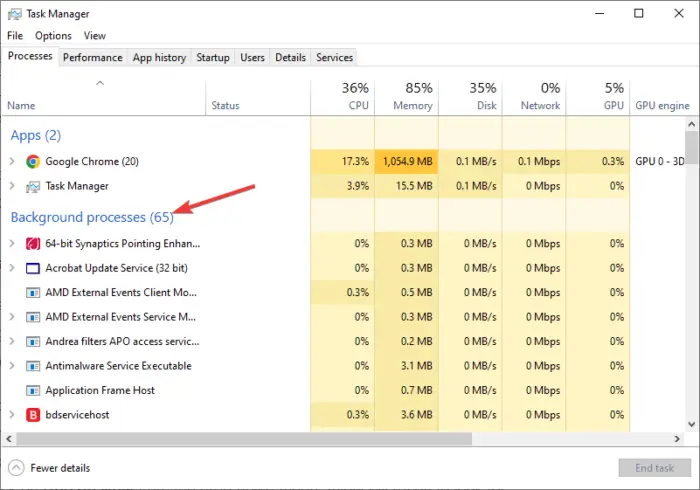
Some background apps might be causing conflicts with MS Access, while some might be consuming huge CPU resources, leaving less for other apps. Here, you need to close these apps and see if the issue is resolved. To close background programs, open Windows Task Manager by pressing Ctrl + Alt + Del. Go to the Processes tab, right-click on any app consuming too many resources and you don’t need, or the one you think is conflicting with Access, and then select End task. After that, test and see if the code error is resolved.
To determine which background apps are conflicting or incompatible with Access, you can perform a Clean Boot on your PC. This will give you an overview of programs, especially third-party apps conflicting with Access.
4] Update MS Office
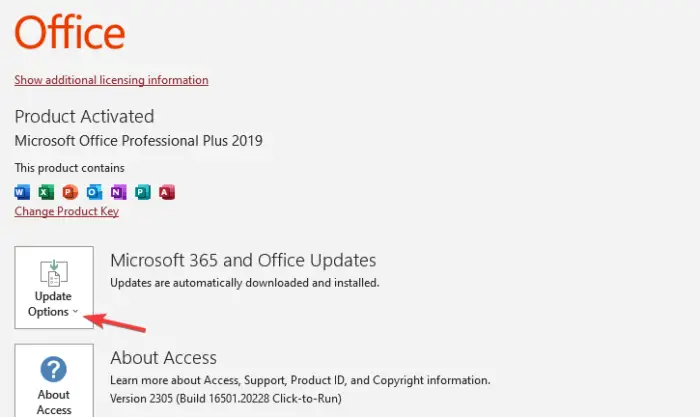
An outdated Access app can trigger a runtime error in Access, and the only best way to fix this is by updating the app manually if you haven’t activated automatic updates. Use the steps below to update Microsoft Access manually;
- Open Access and go to File > Account.
- On the new window, select Update Options which is next to Office 365 and Office Updates.
- Click on Update Now from the drop-down menu. Allow Microsoft to look for updates and install them automatically.
- Finally, close MS Access and restart it and check whether we fixed the error.
5] Scan system files
If there are damaged or corrupted system files, you might get a runtime error when running MS Access. To fix this, run the SFC scannow tool. If that doesn’t fix the issue you may also run the DISM scan. These tools look for any missing or damaged system files and repair them directly. Be patient as the tools might take some time to complete the process.
Related: Fix 30015-4 (5), 0x4004f00d, 30175-11 Office error codes
6] Run the Disk Cleanup tool
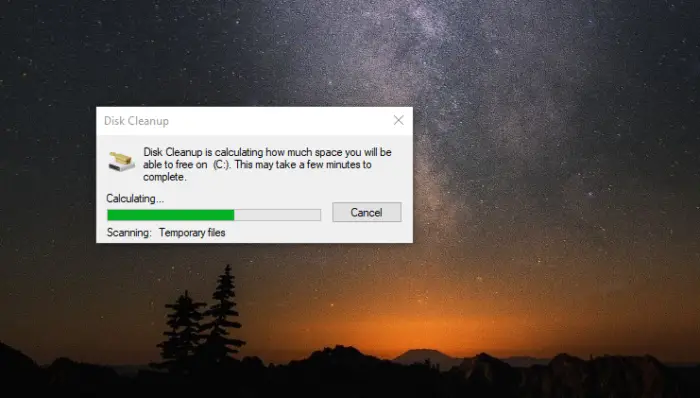
One major cause of runtime errors in Access is the lack of sufficient memory to run the app. This can be fixed by creating more storage space using default tools like Disk Cleanup or other legit third-party tools. Do the following:
- Open the Disk Cleanup tool by searching it on the search bar.
- A new small window will appear. Select the files and data that you want to delete and click OK.
- Navigate through the Disk Cleanup app and check the items you can permanently delete to free up some spaces.
7] Update your graphics driver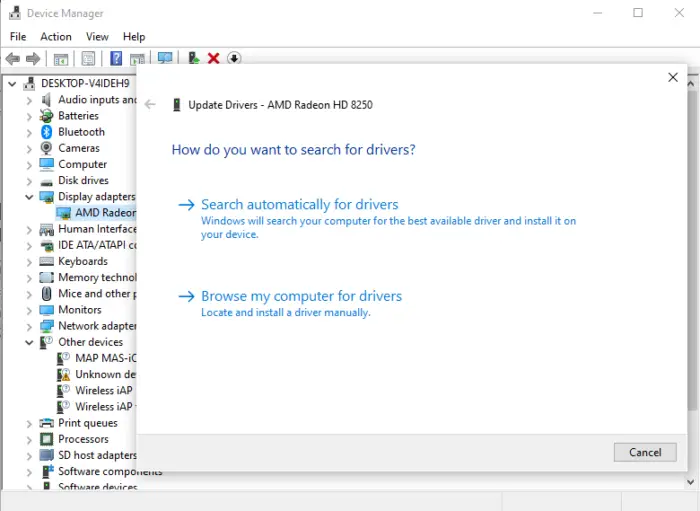
If the graphics driver is corrupted, faulty, buggy or it failed to install properly, you might get the Microsoft Access runtime error codes. To fix this, you need to update or even reinstall the driver to resolve the issue. We covered how to update drivers and you might be interested to learn in order successfully update the graphics driver on your PC. You can either do this in the Device Manager or in the Windows Update settings. In most cases, Windows updates drivers automatically unless that feature is disabled or the update is delayed.
We hope something here works for you.
Fix: File sharing lock count exceeded error in Office Access
How do I fix Microsoft Access errors?
Generally, you can fix Microsoft Access errors by running the Compact and Repair feature, an in-built feature. To do this, open Access and go to File > Option > Current Database > Compact and Repair. This will fix Access errors and damaged MS Access database, and optimize how your app works on your PC. If this does not fix the error you are experiencing, try reinstalling the app, running an SFC scan, scanning for viruses, and other solutions we discussed in this post.
Fix: Microsoft Access is not responding
What causes an Access database to be corrupted?
Access databases can be caused by third-party plug-ins and extensions that are not well crafted to be compatible with MS access. Hardware issues can also trigger Access corruption, such as hard drives and networking equipment. If many users are accessing the database, it might get corrupted if a user is trying to perform a task when the network is down or has issues. Another rare cause of Access database corruption is bugs and glitches which can be fixed by simple workarounds we covered at the beginning of this post.